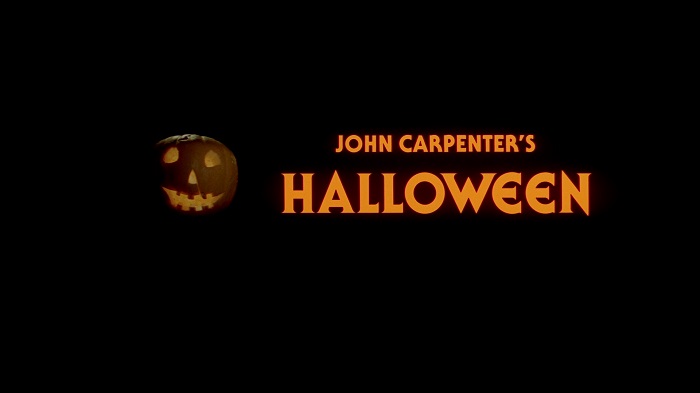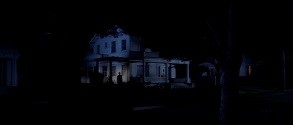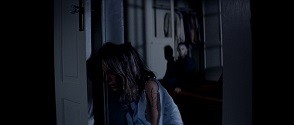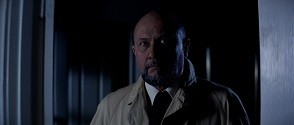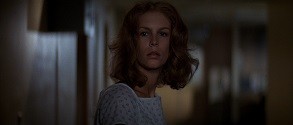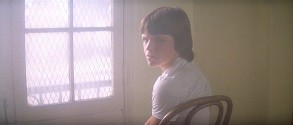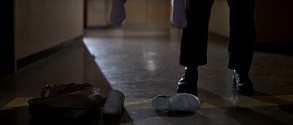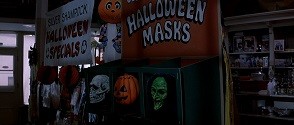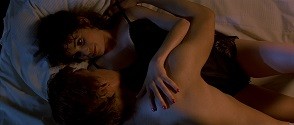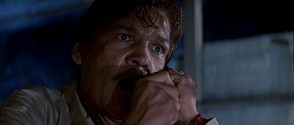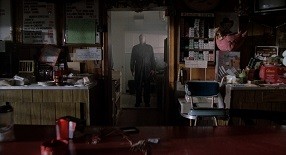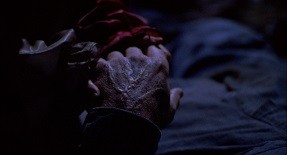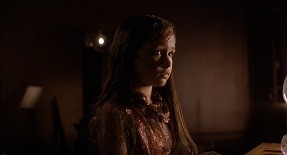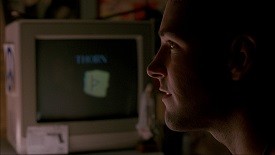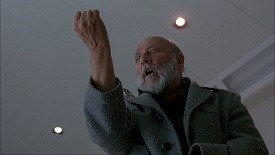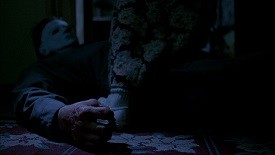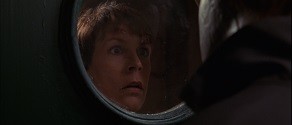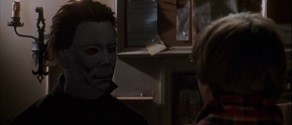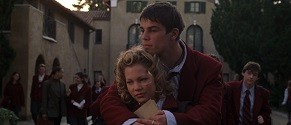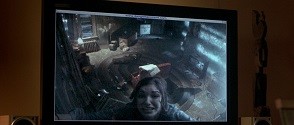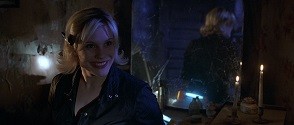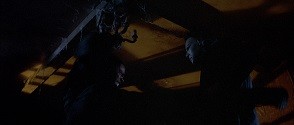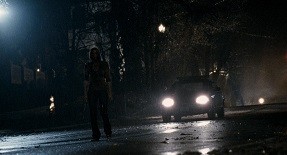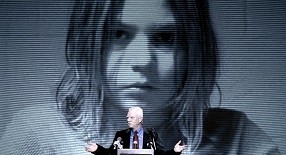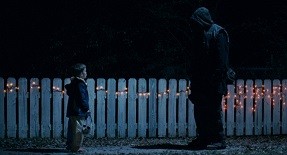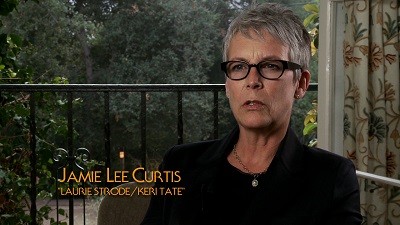| Reviews & Columns |
|
Reviews DVD TV on DVD Blu-ray 4K UHD International DVDs In Theaters Reviews by Studio Video Games Features Collector Series DVDs Easter Egg Database Interviews DVD Talk Radio Feature Articles Columns Anime Talk DVD Savant Horror DVDs The M.O.D. Squad Art House HD Talk Silent DVD
|
DVD Talk Forum |
|
|
| Resources |
|
DVD Price Search Customer Service #'s RCE Info Links |
|
Columns
|
|
|
Halloween: The Complete Collection - Limited Deluxe Edition
With the exception of the Texas Chain Saw Massacre series, few horror franchises have had their rights as widely scattered as the Halloween movies. The original was an independent production, with the sequel options snapped up by a major studio (Universal) after it was a runaway success. Two movies later, the series returned to independent financing for two more, before being picked up by a major again in Miramax's genre-centric distribution arm, Dimension Films. Most recently, the rights followed Bob and Harvey to The Weinstein Company, where two remakes were made, the second of which was distributed on home video by Sony. The resulting mire of rights was so complex that fans never even really questioned whether they could be untangled, the closest collective wish being a special edition-friendly company like Anchor Bay or Lionsgate acquiring the three Dimension entries around the time Miramax crumbled (instead, they were given to bargain label Echo Bridge). Then, unexpectedly, Shout! Factory announced they'd brokered a deal with Anchor Bay (and multiple other rights holders) to make the impossible possible: a box set of all 10 movies, for their Scream Factory line.
Most of you will probably skip down to the A/V and supplemental sections of this review, or maybe scroll through in order to click on all the screencaps. If not, let's dive into the series, shall we?
The original Halloween has been discussed so often that it's almost as much of a cliche to say there's nothing new to say as it is to try and go over what makes it great. John Carpenter's suburban thriller is wonderful in its simplicity, capturing a universal quality about its' quaint small-town setting, and crafting characters that are broad enough for the audience to identify with, yet also distinct and memorable. The vast majority of slasher movies released during the next decade would revert to character types instead of character, filling the same paint-by-numbers outlines for each film, but Carpenter and Hill know where specificity will work wonders. Their little details are so well-observed: the honest exasperation Laurie (Jamie Lee Curtis) feels at having been set up on a date with Ben Tramer, the sarcastic tone of conversations between Annie Brackett (Nancy Kyes) and her babysitting subject Lindsey Wallace (Kyle Richards), the carefree sweetness of Lynda (P.J. Soles) and her favorite phrase ("Totally!").
Carpenter is responsible for some of the greatest horror movies of the last 30 years, and his stark, matter-of-fact direction is just what this story needs. His filmmaking technique also gets two major assists: the theme, which he himself wrote, a perfect summary of the film's style of suspense. Despite having little more than a synthesizer at his disposal, those simple piano notes seem to rise endlessly, an aural illusion that matches Michael's invincibility. The second is Donald Pleasence as Michael's former therapist, Dr. Sam Loomis. It's fair to say Pleasence is hammy in the role, but it's the right kind of hammy for Halloween, with each whispered description of Michael's soulless eyes filling in detail Carpenter opts not to show. It's easy to forget how minimal Michael's physical presence is in the movie is during the first half of Halloween, because the theme and Loomis' warnings build the character up to mythical proportions. When Michael finally stops lurking and starts picking his victims, his presence rides a wave of suspense. In this way, Carpenter pulls off a feat that few other directors could: get the audience to take a character they're seeing on screen and fill him with their imaginations.
The success of Halloween made a sequel inevitable, but it was undoubtedly the runaway success of Friday the 13th in 1980 that really lit a fire under Carpenter and Universal to bring Michael back. The film was released alongside a TV version of the original that featured new scenes to tie the two stories together, and the sequel itself boasted the return of Donald Pleasence and Jamie Lee Curtis in the lead roles. On one hand, Halloween II marks the beginning of the series' transformation into a more generic slasher franchise. Halloween II can't be blamed for the creative choices of every other Halloween sequel, but it certainly opened some doors that were never closed again. On the other hand, Halloween II is one of the better follow-ups in the series, taking a similar (if not equal) amount of time developing suspense and focusing on character, as well as making the fun decision to begin exactly where Halloween left off.
Losing a director like John Carpenter (even if some of his most famous films were yet to come) would generally spell doom for a follow-up, but his replacement, Rick Rosenthal, clearly understands why Halloween is so effective. The film opens with a fantastic first-person sequence referencing the prologue to the first film, illustrating Michael's journey away from the Doyle house and into the night. Along the way, Rosenthal fills the story with memorable bit characters and follow-up beats from the first film, such as Charles Cyphers' Sheriff Brackett discovering what happened to his daughter. The decision to pick up exactly where Halloween left off adds a great sense of unity to the films that so many sequels fail to capture. Curtis' Laurie has become much less talkative (understandable), and Pleasence has gone from slices of ham to the entire pig, but the performances and overall tone of the film are in keeping with the original.
Ironically, it was Carpenter, not Rosenthal, who contributed most of the things die-hard Halloween dislike about the sequels, both in terms of Halloween's ongoing narrative and utilizing elements that would become tropes of slasher films in the 1980s. It's Carpenter who introduces new twists to Laurie and Michael's history to connect the two, and he would later go onto reshoot a number of the film's kill sequences with more blood and gore, a move motivated by Friday the 13th. Rosenthal objected, having taken great pains to mimic Carpenter's tone, but the revisions stayed in the final cut. For some, that's a disappointment, and those complaints are understandable, but these moments hardly take away from the film's fun interactions between Laurie and an EMT (Lance Guest), or take away from the suspense Rosenthal establishes before Michael moves in for the kill. It's an imperfect movie, and merely "pretty good" to Halloween's great, but even its flaws are interesting developments in Halloween's evolution as a series.
In every long-running film series, there's always a red-headed stepchild, and Halloween III: Season of the Witch is that movie. Having provided what he felt was a definitive end to the Michael Myers saga, John Carpenter hoped to take the series in a new direction: every year, a new character or story set on Halloween night. Carpenter had previously offered Tommy Lee Wallace, editor on the original Halloween, a chance to direct Halloween II, but Wallace had passed because he was unhappy with the script. When a first draft by British author Nigel Kneale didn't satisfy Carpenter, he offered Wallace the chance to rewrite the script in addition to directing, and he jumped at the opportunity.
Genre superstar Tom Atkins is Daniel Challis, a doctor working a night shift in the ER when a terrified patient comes in, raving about a murder plot. Challis manages to subdue him, but a man walks into the hospital shortly thereafter and murders the panicked patient, then walks out to the parking lot, climbs into his car, douses himself in gasoline, and blows himself up. The only clue Challis has to what the victim was frightened of is a cheap Halloween mask, manufactured by Silver Shamrock, already infamous for its notoriously catchy TV jingle. Challis goes out to their factory to investigate, and runs into a bigger mystery than he expected, as well as Ellie Grimbridge (Stacey Nelkin), daughter of the dead man, also interested in getting to the bottom of a suspicious story.
Season of the Witch is a fun diversion from the franchise's usual beats, a "Twilight Zone"-esque B-movie filled with a number of delightfully bizarre twists and turns. For years, the movie languished in the shadow of Michael Myers, but since its' release on US DVD several years ago, its cult following has grown. There are certainly some dry spots and leaps of logic, but Wallace finds a specific tone that captures the spirit of the holiday -- not quite silly, but definitely a bit tongue-in-cheek, aiming for the same attitude as a good campfire story. It helps that Wallace has Atkins, one of horror's most reliable character actors, lending a nice air of authority that whittles away into a delightfully sweaty panic. Nelkin proves a strong co-lead as well (even if the romance between Challis and Ellie seems like wishful thinking), and Dan O'Herlihy, best known for his role in RoboCop, does a similar bit as the sinister CEO of Silver Shamrock. At the very least, the movie builds to a perfectly wicked ending, one that will only further cement that damn jingle's place in your memory for the rest of your life.
Despite Carpenter and Wallace's efforts, audiences felt they had been promised a series about Michael Myers, and the resulting poor showing at the box office convinced Moustapha Akkad to agree with them. Carpenter left the series (for good, despite a couple of efforts to lure him back over the years), and so did Universal. Akkad then teamed up with producer Paul Freeman, and hired director Dwight H. Little and writer Adam B. McElroy to craft a story that would re-center the series on Michael. The duo did Akkad one better: they also resurrected Sam Loomis, last thought to be dead at the end of Halloween II, and convinced Donald Pleasence to come back. Furthermore, they created the character of Jamie Lloyd (Danielle Harris), who would be the focus of not just Halloween 4: The Return of Michael Myers, but also Halloween 5: The Revenge of Michael Myers.
Although the two films are a pair, they stand at almost opposite ends of the sequel spectrum. Halloween 4 is probably the closest of the series' sequels to being fully successful -- Halloween II is a close second, but 4 is free of the tonal discord of two directors with different ideas about the kill scenes, and features a wild twist ending packed with promise. Halloween 5, comparatively, feels tied to its template, rejecting the potential of 4's send-off for conventional ideas and repetitive characters. It's a mistake the Akkads would make at at least one other time: riding high on the success of one re-energizing Halloween sequel, they rushed another into production with a different creative team that would undo much of the goodwill they'd just created.
4 gets off on the right foot by assembling a strong, charismatic cast. They may not have the right mix of details that made characters from the original Halloween work so well, but the performers playing the roles have enough charisma to get around it. Ellie Cornell plays Rachel, a shy girl-next-door type whose inner reserves come out when she has to fend for her life. She's attracted to Brady (future Dazed and Confused star Sasha Jenson), a checkout clerk at the local corner store, but Kelly Meeker (Kathleen Kinmont) either has her eye on him or just wants to cause trouble, a likely form of rebellion for the daughter of the town's dependable sheriff, Ben Meeker (Beau Starr). Pleasence, having developed new facets of silliness in his absence, again tears into the role of Loomis, his warnings as ominous and insistent as ever.
Of course, neither of these movies would work without a great lead performance, and young Danielle Harris shines in the role. Jamie Lloyd is Laurie's daughter, orphaned after Laurie's death in a car accident, and she's been adopted by Rachel's family, but she's tormented by visions of Michael she doesn't understand. Plenty of kids could look kid-cute and scared at the same time, but Harris brings a shocking depth and range to depicting her grief that really lifts both movies up (even when the screenplay for 5 arbitrarily decides to rob the character of her ability to speak, then returns it just as unexpectedly around the halfway point). She's got excellent sisterly chemistry with Cornell's character that feels genuine, and holds her own with Pleasence at full tilt.
It may be easier to say "show me that movie" rather than try and actually imagine what it would be, but the excitement of Halloween 4's ending is mostly in the idea of seeing Harris' hypothetical performance. Instead, 5 relegates her to a hospital bed, followed by generic action theatrics with a series of new victims (primarily Wendy Kaplan, who differentiates herself in performance but serves the same purpose as Rachel), while Loomis approaches peak hysteria inside the Myers house. Where Halloween 4's ending surprises, Halloween 5's ending embarrasses, when a character wipes a single tear from Michael's eye. Oh, brother (uncle?).
In what could kindly be called a questionable strategy, Halloween 5 contains a shot of a strange tattoo on Michael's wrist, as well as a couple of moments with a mysterious figure, dressed all in black. These days, the producers admit it was just smoke and mirrors -- the meaning of the tattoo and the identity of this hugely important person in Michael Myers' legacy were all something they figured they'd make up later. When Halloween 5 wasn't a hit, "later" turned out to be several years down the road, with the support of Dimension Films, winner of a bidding war for the rights. In a fairly unprecedented move, Halloween fan Daniel Farrands wrote the screenplay, a love letter to the franchise he loved so much that was so elaborate, the Weinsteins had him split his original draft into two films that would really dive into new mythology behind the man in black and Michael's mysterious tattoo. Unfortunately, somewhere between the script and the screen, everything went to hell.
In its theatrical form, Halloween: The Curse of Michael Myers is the worst film in the entire series. Nonsensical, obnoxious, unintentionally silly, and incredibly tedious, nothing works. In his debut role, Paul Rudd seems horribly miscast or already fed up with the rewrites and changes, as he delivers his lines almost the same way he delivers comic sarcasm in his current comedies. Pleasence, in his final appearance as Dr. Loomis, feels almost like an afterthought, showing up in scenes just to lead characters to the next one. Gore skips far over Halloween II's "amped up" to "outrageous" -- at one point, someone's head explodes. As the film draws to a close, the movie totally jumps the rails, with an inexplicable scene about surgery that I didn't understand the first time I watched the film, and still don't understand now. To add insult to injury, the film also takes what seems like a despicable glee in dispatching Jamie Lloyd in the most gruesome way possible, and without the benefit of Danielle Harris, who was replaced by J.C. Brandy. Most of these changes were imposed by Dimension and forced onto director Joe Chappelle, who struggled to balance the original screenplay, the needs of the Weinsteins, and the needs of the Akkads all at once.
Thankfully, with this box set, fans can finally experience The Producer's Cut, which is a testament to how much editing can change a movie. It's not just the later half of the film that improves, with its extensions and additional scenes, but the entire movie, which has room to breathe. A number of small moments are restored to Marianne Hagan's performance as Kara Strode, revealing the character's warmth and sense of humor. Kara's mother, Debra (Kim Darby), seems almost mentally incompetent in the theatrical cut, but a few additional lines and insights turn her character back into a recognizable human being. The film's opening narration is delivered by Pleasence instead of Rudd, which moves Rudd's character, Tommy Doyle (the boy Laurie was babysitting in the original) back into the more comfortable outsider position -- when he narrates, the audience is forced to identify with his eccentricities and oddness. The cut also reveals more of Pleasence's performance, which is quiet and measured, a nice pull back from Loomis' raving in the previous film, and develops the relationship between Loomis and Dr. Wynn (Mitch Ryan) more clearly. The only bittersweet note of the whole experience is that it builds to a second wild twist ending that would never be realized, thanks both to Pleasence's passing at the end of production, and an idea about how the series could ring in its 20th anniversary.
Much like Heather Langenkamp would do with the Nightmare series, an older Jamie Lee Curtis returned to the franchise that launched her career. Seeing the 20th anniversary as an opportune moment to celebrate the original and honor the fans, Curtis attempted to get John Carpenter and Debra Hill on board with a new movie. Her efforts were ultimately unsuccessful, but she had a second choice in director Steve Miner, who directed her in Forever Young a few years earlier. They also had some work done by new horror prodigy Kevin Williamson, whose Scream had turned horror back into big business just a couple of years earlier. Williamson was busy with commitments to "Dawson's Creek", but he helped develop the project in its earliest stages before writing duties were given to Robert Zappia. The resulting film is far from perfect, but for most of its running time, it's a surprisingly satisfying closing chapter (yeah, you read me right) to Laurie's journey.
As with any good Halloween movie, Halloween H20: Twenty Years Later focuses more on character than horror. Laurie has moved to California and gone into the Witness Protection Program, now living a full life as Keri Tate, headmaster of a posh private school. Her love life's going pretty well, having begun seeing the school's guidance counselor Will (Adam Arkin) in secret, and she's got a 17-year-old son, John (Josh Hartnett), who loves her but is less enamored with her clingy paranoia. The movie is driven by Laurie's psychological wounds, and the way they're affecting John's freedom. According to Curtis in the set's many supplements, portraying Laurie's psychological state was part of what drew her to the idea of revisiting the series, and it shows. Laurie's been split into two people, someone traumatized by her experience and someone determined never to let it happen again, and Curtis segues in and out of these two sides naturally throughout the film. In his first movie role, Hartnett displays the same confidence and charisma that he does today (albeit a little brattier). The film also features Michelle Williams as John's girlfriend Molly (a thin and thankless role, despite Williams' charm), LL Cool J in a funny role as a security guard and would-be romance novelist, Nancy Stephens as Marion (the only other actor to appear in all three Jamie Lee Curtis films), and Curtis' mother, Janet Leigh, as Laurie's secretary (utterly charming and very funny).
As the film builds suspense, Miner effectively evokes elements of Carpenter. Reflections and windows are a constant, and there are some moments that physically call back to the original (namely, the idea of Michael falling over a railing off a balcony). Stunt performer Chris Durand doesn't quite move as robotically as Nick Castle, and all three versions of the mask look fairly horrible, sapping a little bit of energy from the family reunion, but it works more often than not, sustaining the tension even when the scene is silly (Curtis rolling around on the floor underneath tables never quite works).
That said, the real issue with H20 is the extended finale, which feels like it belongs to some other movie. It's fair to say that Laurie's journey has given her plenty of reason to doubt herself and second-guess everything, but her leap to action in the film's finale is a bit odd, as if the movie is missing a transitional scene where she actually makes a choice, or sees some reason to act. To add insult to injury, the long game being played by the producers is painfully obvious, and takes away from Laurie's triumph. The filmmakers intend to close the movie with a crowd-pleasing exclamation point, and it almost certainly worked, but viewers watching at home, knowing that the filmmakers immediately turned around and redacted it (along with most of the character arc that Laurie experiences) in the very next film reduces the movie's bang to a whimper.
Halloween 6 is still my pick for worst Halloween movie, but Halloween: Resurrection is a real contender, one that ends up feeling the most insulting to the original's legacy. After H20's cathartic conclusion to Laurie's story, Resurrection insistently rips that thread back open, unleashing one of the silliest retcons I've ever seen (and I love the Saw movies, so I know all about silly retcons). This is followed by a sequence that just hurts me to think about, a totally undignified appearance by Jamie Lee Curtis that stinks of contractual obligation rather than any sort of awareness of her character or what that character meant to the series. Most of Resurrection is just stupid, but, as a fan, the prologue is actually offensive, actively spitting in the face of the film that paved the way for a resurrection in the first place.
In addition to being awful, Resurrection is also the most dated movie in the box, packed to the brim with late-'90s / early-2000s trends and tech that quickly became obsolete. The story is set around a reality show filming a live webcast inside Michael's house on Halloween, which hardly jives with Curse's vision of a Haddonfield that banned Halloween for a decade out of fear that it would bring Michael back. The show is led by Busta Rhymes, playing show producer Freddie Harris. It's a ridiculous, cartoonish performance that is fun in doses, but Rick Rosenthal (returning from Halloween II) and the producers are too eager to indulge. In the lead, Bianca Kajlich is Sara, coerced into joining the show by her fame-hungry friend, Jen (future star Katee Sackhoff), with only her mysterious internet friend "Deckard" -- actually teenager Myles Barton (Ryan Merriman) to comfort her. They communicate over Sara's Palm Pilot, possibly via email, which the filmmakers seem to think is the same as a Yahoo! chat room.
The conceit of Resurrection is that the audience will be able to watch Michael from a number of angles, just like Myles watches Sara on the live webcast. It could be okay, but Resurrection is insistently cartoonish, failing to capture anything resembling atmosphere or tone. Busta Rhymes wanders the house, yelling jokes to himself, while the rest of the cast -- all playing the kind of "types" that Carpenter and Hill carefully avoided -- aimlessly explores empty rooms, making lame banter. Some of the performances are fine, but nothing in the story ever grabs or sticks, with the film's major suspense sequence, where Myles tries to clue Sara in on where Michael is by watching the webcast, plays very "rinse and repeat" after a few moments. It's no surprise that after this entry, the producers felt there was nowhere left to take the original series. Too bad they couldn't have decided that one movie sooner.
With Halloween: Resurrection strongly suggesting the series was creatively struggling, Malek Akkad decided to try a different angle at reinventing Michael for the modern age: a remake. For awhile, it was rumored that Rob Zombie's film would actually be Halloween 9, but it turned out to be a new version of the original that stretched the "young Michael" portion of the movie out to about the halfway point, and shrinking Laurie's story accordingly. Zombie cast Malcolm McDowell as Sam Loomis, Scout Taylor-Compton as Laurie Strode, his wife Sheri Moon Zombie as Michael's mother, and Daeg Faerch as young Michael / Tyler Mane as adult Michael, and the results were divisive, to say the least.
Personally, I've never agreed with the idea that knowledge or understanding gets in the way of horror. Many viewers complained that Michael's mystique was part of what made him frightening, and that may be true, but there's plenty of ways to scare an audience, not to mention an objective examination of Zombie's Halloween reveals he doesn't exactly explain away Michael's psychosis. Zombie is often attracted to white trash types in his horror movies, and his version of the Myers household is no different, with dad (William Forsythe) screaming at his wife and kids (Hanna Hall as Michael's older sister) over the breakfast table. Michael is also bullied at school by an older boy (Daryl Sabara), who taunts Michael with an ad for his mother's show at a local strip club, but Michael's sister isn't crazy, and Michael is introduced murdering one of his pets. Something unexplained corrupts Michael, fills him with a clear desire to create violence, Zombie's embodiment of the evil that Loomis (both the past and present versions) sees in the child's eyes. When young Michael finally retreats inside himself for the last time, it captures the spirit of those ideas from the original Halloween. Zombie also gives his wife a nice (if predictably despairing) arc, a mother who can't even begin to reconcile the idea that her sweet boy took a knife and slaughtered the rest of her family. It's brutal and dark, and for many it will be too much to stomach, not to mention far different than Carpenter's no-frills original, but in this writer's opinion, Zombie finds the right balance between the ideas of Halloween and his own vision.
That said, these choices only make up the first half of the movie, and as the film cuts to Michael as an adult, Zombie loses some of his focus, shifting instead to a repellent guard (Lew Temple) and his torment of Michael. His relationship with a different guard (Danny Trejo) is much more interesting, featuring Trejo at his most kindly and paternal, a display of understanding that doesn't affect Michael at all. The real change from Carpenter's movie, however, is the personalities of Laurie, Annie (Danielle Harris, returning to the series), and Lynda (Kristina Klebe). The characterizations of the girls in Zombie's film is infinitely more aggressive, their mannerisms amped up to 11. At times, they can get obnoxious, which is arguably the element that strays furthest from the relatable characters from the original movie. The violence, however, is terrifying in its relentlessness, and Zombie populates the experience with familiar genre actors like Brad Dourif as Sheriff Brackett, Ken Foree as an unlucky truck driver still living in the 1970s, and Dee Wallace as Laurie's mother.
For a short while, it appeared Zombie's time with the series was a one-and-done deal, but he was eventually lured back for a Halloween II that branches off into its own interesting territory. Zombie frequently stated that his concept for the sequel had to do with Laurie having to learn that her brother was a notorious serial killer on top of the fact that many of her friends and family are dead. It's an intriguing idea even as it gets muddled slightly with psychoanalytical visions of Mrs. Myers and a white horse, and inconsistency in the way the characters act. Laurie is now living with Annie and Sheriff Brackett, still tormented by her experience. So far, she's been protected from the knowledge that Michael was her brother, but Loomis (who appeared to be dead at the end of Halloween) has ditched medicine to become a talk show fixture, writing a book on his years with Michael and trying to hide from the horror of the experience under sunglasses and a slick suit.
Again, Zombie explores the aftermath of the incidents that made up his Halloween, allowing for a scene where Lynda's father confronts Loomis at a book signing with a gun, or the deterioration of Laurie and Annie's friendship in the wake of their individual traumas. Once again, he wallows a little too much in gloomy horror tropes (namely rape), but the film retains the same adrenaline-rush terror of his previous film, and features a stronger story not beholden to any others (despite an extended prologue inside a hospital). It's a messy film, but a fascinating one, one that at least attempts to break new ground in a series that previously appeared to have exhausted its creative possibilities.
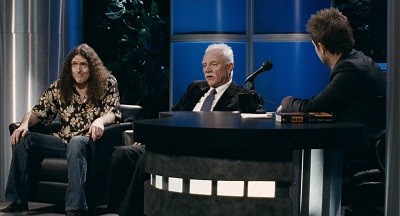 The Blu-ray
The Blu-ray
Anchor Bay and Shout! Factory bring the 15-disc Limited Edition version of the complete Halloween series home in a sturdy cardboard box, featuring brand new artwork by Paul Shipper (plenty of guys try to follow in the footsteps of Struzan, but this guy's work comes the closest that I've seen) on the front and back, and the classic pumpkin on the "spine." On the other side, the box opens to reveal 10 pitch-black eco-cases housing the set's 15 discs -- 2 in Halloween, Halloween II, Halloween 6, Halloween (2007) and the bonus disc for the whole set inside Halloween II (2009), and the rest with one disc each. The individual covers are the films' original theatrical key art on a black backdrop, which creates a nice unified effect (even if the Scream style lineup posters for H20 and Resurrection seem kind of out-of-place). Also tucked inside the box, before the first film, is a reasonably lengthy booklet with an overview of the series by Michael Gingold. Some fans have complained about the lack of physical frills, and I admit I would have probably preferred non-eco casing, but I'm all about the attractive simplicity of this set. EDIT (9/28/2014): The first disc of Rob Zombie's Halloween has disc art that corresponds to a Region B disc and the rating logo for another country, but the actual disc is unaffected.
The Video and Audio
Before we dive into the video transfers and sound mixes up for grabs here, the two separate transfers for Halloween, and the transfers for Halloween II, Halloween III, Halloween 4, Halloween 5, Halloween (2007), and Halloween II (2009) are all identical to the transfers that are currently on the marketplace, and in fact, with the exception of the altered mono and new commentary on the first Halloween disc and the Halloween 4 disc (jump down a few paragraphs), these are all the exact same discs released individually (short of the disc artwork). For an assessment of these, please click through to any one of the reviews linked above.
The one most people are probably curious about is the new transfer of Halloween: The Curse of Michael Myers - The Producer's Cut, reportedly done from the original negative. The only versions that were previously available were all bootlegs done off what appeared to be a VHS-quality source, so this 1.78:1 1080p AVC presentation will be a revelation anyway, but the film looks noticeably better than the theatrical cut presented on the previous disc. Detail is stronger and appears more natural, and the image has more depth, even when shadows tend toward the impenetrable. A sheen of film grain is visible and appears generally well-rendered, although many Shout! critics will probably still note some chunky compression in some of the darker scenes. 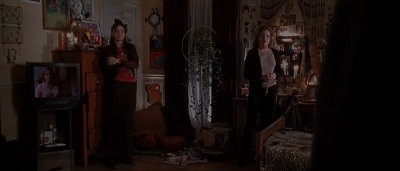 Colors have a touch more life to them, and there are no instances of banding throughout the film. This isn't a restoration -- it looks like a film from the '90s -- but finally, it can be seen in a quality version more than comparable to very good transfers of films the same age.
Colors have a touch more life to them, and there are no instances of banding throughout the film. This isn't a restoration -- it looks like a film from the '90s -- but finally, it can be seen in a quality version more than comparable to very good transfers of films the same age.
The other big question is the appearance of H20: Twenty Years Later, which was butchered by previous distributor Echo Bridge in a disappointing open-matte 1.78:1 edition. Restored to its intended aspect ratio of 2.39:1 and presented in 1080p AVC, this is a slightly above-average HD transfer, the kind that many would be perfectly happy with from a bargain disc but may be a bit more critical of in a box set like this. Shadows can look a little flat, colors may not be "new movie vibrant", and some level of detail is probably being lost, but the overall appearance is free of issues and is clearly HD. The original DVD of H20 is also non-anamorphic, so there's no question this is a significant upgrade over that disc as well. All things considered, there are so many video transfers on the market that have been harmed by tweaks, a transfer with room for improvement but no flaws is still a plus in my book.
Reports online have claimed that Halloween: Resurrection's 2.39:1 1080p AVC transfer is new. I never saw the Echo Bridge disc, so I'm taking their word that it's not the same. Despite being a new movie, this is a worse transfer than the one for H20, with more exaggerated, noisy grain in light scenes and crushed blacks in dark scenes. Colors appear drab, and a touch of sharpening may be present, however, all of this seems to stem from the source materials rather than tweaks applied to this transfer.
EDIT (9/28/2014): While there isn't much to say about its aural qualities, other than it sounds authentic, fans will be happy to know that the mislabeled "original mono" from the initial 35th Anniversary Blu-ray of Halloween has indeed been corrected (previously, the "mono" was simply a downmix of the new 7.1 mix with alternate sound effects). It's a shame there's no replacement program for those who already bought the individual edition, but purists will be relieved to know it's right this time around.
Sound for The Producer's Cut is available in two lossless audio tracks: a new DTS-HD Master Audio 5.1 remix, and a DTS-HD Master Audio 2.0 Stereo track. One of the most obnoxious aspects of the theatrical cut of Curse was a number of quick-cut montages, generally of people screaming, and a hilariously bad electric guitar through most of the film's nonsensical finale. Without these elements, and many of the more "action"-oriented sequences removed, The Producer's Cut is a bit more low-key, focusing more on dialogue, but both tracks still sound fairly nice, immersing the viewer on more of a psychological level than a directional level. Personally, I think I might've preferred the bolder stereo track than the quieter 5.1 remix, but both are available for fans to choose from.
Sound for H20 is also DTS-HD Master Audio 5.1, and it sounds pretty great. This is an energetic, nicely directional mix which captures the frenetic action and atmosphere of the movie, including the creaking of that dumbwaiter crawling up to the top floor. Halloween: Resurrection -- DTS-HD Master Audio 5.1 again -- is, again, not quite as good, with a bit less effort put into atmosphere. It's less the mix than the mixing, which just comes off as favoring aggression over artistry.
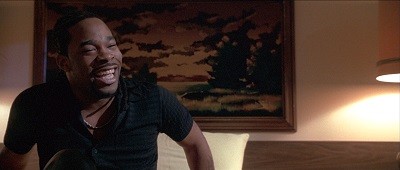 Unfortunately, in a set this big, there are bound to be issues, and one such issue arises on Halloween 4. Despite the same menus and technical specifications, Anchor Bay re-authored this disc in order to remove a feature (more on this in the last two extras paragraphs), and the new disc has a sound sync issue that starts occurring around 40 minutes in and resolves itself near the end of the movie. Although some users have reported their copies are unaffected, the sync error is part of the audio track and is therefore present on all copies. EDIT (10/10/2014): Anchor Bay has just posted on their facebook page about how to obtain a replacement. I have submitted a request. EDIT (01/18/2015): The replacement disc is essentially a reprint of Anchor Bay's stand-alone edition of the movie, minus the panel discussion that was removed for this set. Disappointingly, the disc artwork does not match the rest of the set.
Unfortunately, in a set this big, there are bound to be issues, and one such issue arises on Halloween 4. Despite the same menus and technical specifications, Anchor Bay re-authored this disc in order to remove a feature (more on this in the last two extras paragraphs), and the new disc has a sound sync issue that starts occurring around 40 minutes in and resolves itself near the end of the movie. Although some users have reported their copies are unaffected, the sync error is part of the audio track and is therefore present on all copies. EDIT (10/10/2014): Anchor Bay has just posted on their facebook page about how to obtain a replacement. I have submitted a request. EDIT (01/18/2015): The replacement disc is essentially a reprint of Anchor Bay's stand-alone edition of the movie, minus the panel discussion that was removed for this set. Disappointingly, the disc artwork does not match the rest of the set.
All of the new discs in this set (the first disc, and the four discs for the three Miramax films) all offer English subtitles. Anchor Bay's re-pressed discs (disc 2, and those for Halloween 4 and Halloween 5) also offer English subtitles, and the Zombie movies do as well (the first one also has Spanish). Sadly, the repurposed Anchor Bay discs for II and III still do not have any subtitles.
The Extras
As mentioned in the prior section, nine of the fifteen discs in this set are unaltered from previous editions (the second disc of two for Halloween, the two discs for Halloween II (1981), the discs for Halloween III and 5, both discs for Rob Zombie's Halloween, and the disc for his Halloween II). Please scroll back up to the video section and click on the links for a full rundown of the content on those discs. There is also no significant new content on the first disc of Curse's two discs (a stills gallery and some trailers are included).
The new content starts on the first disc, in the form of a brand-new audio commentary by director of photographer Dean Cundey, Editor Tommy Lee Wallace, and Nick Castle, who played Michael (aka "The Shape"). Carpenter, Curtis, and Hill have spoken about the movie at length (both recently and in documentaries that have been recycled on plenty of the many editions over the years), so it's great to hear stories from less-frequent contributors. Wallace and Cundey dominate the track with their memories from the shoot, talking about the composition of shots, the technical challenges of making the movie, and what it was like working on such a minimal budget, with Castle jumping in occasionally to crack a joke or share an anecdote. It's very compliment-heavy, but with all three men recorded together, this is a lively (if not overwhelmingly insightful) addition to an already strong collection of supplements for the original movie.
One of the set's big treasure troves is next: the Halloween 6 Producer's Cut Blu-ray features a massive collection of brand-new content. The Producer's Cut itself could be considered a bonus feature, but that's covered up in the body of the review, in case you skipped here. Farrands makes his only appearance via an audio commentary with composer Alan Howarth. Obviously, the focus of the discussion is on the differences between both Farrands' original screenplay and the Producer's Cut, and the differences between the Producer's Cut and the theatrical cut. Farrands also covers his inspirations for and disappointments with the film, as well as the elements he enjoys, with Howarth is mostly along for the ride, infrequently chatting a bit about the score and what it was like working on the two versions of the movie. Rumor control is also an ongoing topic, with Farrands clarifying and rejecting a number of theories about the film's development history. All-in-all, this is a low-key experience, focused more on the lore of the script and two versions of the film than production, but certainly worth a listen for those interested in hearing from Farrands.
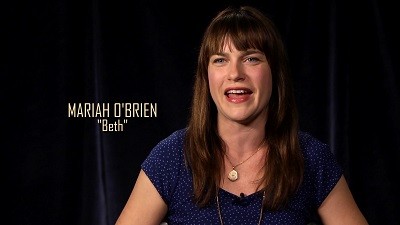 Curse's video features start with "Acting Scared with Mariah O'Brien & J.C. Brandy" (19:25, HD), which sits down with two of the film's leading ladies for their general memories of the shoot. O'Brien is a bit blandly complimentary when speaking about her co-workers, but opens up more when talking about her own experience auditioning and deciding to take the role. She also tells a fun story about Edgar Wright that fans will enjoy. Brandy recalls her audition, when she learned she was taking the role over from someone else, conversations about her hairstyle, and the experience working on the reshoots. "The Shape of Things: The Murder and Mayhem of Halloween 6" (11:36, HD) sits down with makeup artists John Carl Buechler and Brad Hardin, and George P. Wilbur, who played Michael Myers. They talk about re-sculpting the mask (one of the main issues with keeping it consistent is it depends on the shape of the actor's face), their involvement (or lack of it) with the reshoots, and the "over-the-top" effects of the theatrical cut. Buechler seems a little unsure of how to phrase himself sometimes in order to avoid stepping on any toes, which is interesting. "Haddonfield's Horrors: The Visual Design of Halloween 6" (11:17, HD) brings in director of photography Billy Dickson, production designer Bryan Ryman, and second director of photography Thomas Calloway (the reshoots) to chat about their involvement. Dickson and Ryman have a really unique perspective on the making of the film that aren't always discussed in supplements, so their discussion of the production is one of the better features on the disc (admittedly, I watch more of these things in a month than most people do in a year, so your mileage may vary). Both make reference to the other films (Dickson talks about being a fan of Cundey), which is also fun. It's also interesting to hear Calloway's perspective, which is that he got to do a ton of wide-ranging set-ups in a short amount of time, so for him it was a positive experience even if Dickson is not a fan of the new footage. "A Cursed Curse" (10:00, HD) is a measured discussion of the film's production history by Malek Akkad and producer Paul Freeman. Akkad is as diplomatic as possible, but it's a nice overview of how the film ended up with two cuts, as well as Akkad's note that "The Producer's Cut" wouldn't necessarily have been their final version, either. "Full Circle with Composer Alan Howarth" (7:27, HD) is a brief chat with the man behind most of Halloween's music (having not composed the classic theme, he refers to the position as "arranger" rather than "composer"). He touches on the cult stuff, and the changes to the score done in the other cuts. Worth a look, but arguably the least-essential featurette on the disc. "Jamie's Story" (7:35, HD) has actor Danielle Harris setting the record straight on her lack of involvement in Halloween 6 (including a plea to fans to be nice to Brandy; the two actors are friends). Well worth a look for fans of the actress. "Cast and Crew Tribute to Donald Pleasence" (3:07, HD) is a brief series of recollections by the cast and crew of Halloween 6. It's almost a shame that Shout! didn't grab footage with Harris or any of the other folks newly interviewed for this set who worked with Pleasence, rather than just those involved with Halloween 6.
Curse's video features start with "Acting Scared with Mariah O'Brien & J.C. Brandy" (19:25, HD), which sits down with two of the film's leading ladies for their general memories of the shoot. O'Brien is a bit blandly complimentary when speaking about her co-workers, but opens up more when talking about her own experience auditioning and deciding to take the role. She also tells a fun story about Edgar Wright that fans will enjoy. Brandy recalls her audition, when she learned she was taking the role over from someone else, conversations about her hairstyle, and the experience working on the reshoots. "The Shape of Things: The Murder and Mayhem of Halloween 6" (11:36, HD) sits down with makeup artists John Carl Buechler and Brad Hardin, and George P. Wilbur, who played Michael Myers. They talk about re-sculpting the mask (one of the main issues with keeping it consistent is it depends on the shape of the actor's face), their involvement (or lack of it) with the reshoots, and the "over-the-top" effects of the theatrical cut. Buechler seems a little unsure of how to phrase himself sometimes in order to avoid stepping on any toes, which is interesting. "Haddonfield's Horrors: The Visual Design of Halloween 6" (11:17, HD) brings in director of photography Billy Dickson, production designer Bryan Ryman, and second director of photography Thomas Calloway (the reshoots) to chat about their involvement. Dickson and Ryman have a really unique perspective on the making of the film that aren't always discussed in supplements, so their discussion of the production is one of the better features on the disc (admittedly, I watch more of these things in a month than most people do in a year, so your mileage may vary). Both make reference to the other films (Dickson talks about being a fan of Cundey), which is also fun. It's also interesting to hear Calloway's perspective, which is that he got to do a ton of wide-ranging set-ups in a short amount of time, so for him it was a positive experience even if Dickson is not a fan of the new footage. "A Cursed Curse" (10:00, HD) is a measured discussion of the film's production history by Malek Akkad and producer Paul Freeman. Akkad is as diplomatic as possible, but it's a nice overview of how the film ended up with two cuts, as well as Akkad's note that "The Producer's Cut" wouldn't necessarily have been their final version, either. "Full Circle with Composer Alan Howarth" (7:27, HD) is a brief chat with the man behind most of Halloween's music (having not composed the classic theme, he refers to the position as "arranger" rather than "composer"). He touches on the cult stuff, and the changes to the score done in the other cuts. Worth a look, but arguably the least-essential featurette on the disc. "Jamie's Story" (7:35, HD) has actor Danielle Harris setting the record straight on her lack of involvement in Halloween 6 (including a plea to fans to be nice to Brandy; the two actors are friends). Well worth a look for fans of the actress. "Cast and Crew Tribute to Donald Pleasence" (3:07, HD) is a brief series of recollections by the cast and crew of Halloween 6. It's almost a shame that Shout! didn't grab footage with Harris or any of the other folks newly interviewed for this set who worked with Pleasence, rather than just those involved with Halloween 6.
The rest of the disc contains archival footage from the set or from the making of the movie. First up is a teaser trailer (1:01, SD) bearing the title Halloween 666: The Origin of Michael Myers. A fun curio, although it consists entirely of footage in the finished film. Archival Interviews and Behind-the-Scenes Footage (8:00, SD) gives fans some time with Donald Pleasence, Paul Rudd, Marianne Hagan, and even director Joe Chappelle in interviews captured for the film's EPK. Given the stories about how little he cared about the franchise over the years, it's interesting for the only glimpse of Chappelle talking about the movie to be a fairly enthusiastic chat about trying to bring the series back toward suspense and his ideas for the style of the movie. The reel ends with some B-roll, featuring Moustapha Akkad. Fans of B-roll will really be thrilled by the following extra, Daniel Farrands' personal footage from the first week of filming (24:04, SD). This fly-on-the-wall material captures the tone of working on the set, the shooting of several scenes, and some goofing around with Hagan as she chats about her character. Predictably unfocused, considering it's personal home movie footage, but there's some fun stuff here. A short collection of deleted and alternate scenes (7:24, SD) not present in either cut of the film is offered. Nearly a third of it is made up of Jamie Lloyd's theatrical death scene, but I couldn't see any difference...the scene with the guy's head being pushed into the metal bars is another story. Finally, the film's electronic press kit (4:51, SD) closes out the disc. Not particularly crucial, as most of it is trailer footage, and the interview footage is all from the previous extra.
Those who owned the Collector's Series DVD of H20 were only provided a featurette and a music video -- not exactly worthy of the special edition label. Shout! has rectified this wrong by making the announced (but never recorded) audio commentary by director Steve Miner and actor Jamie Lee Curtis a reality. I've always wanted to her Curtis' thoughts on the movie, and this fulfills that wish. She willingly elaborates on both the ups and downs of the project's development, including John deciding not to do the film and discovering Moustapha Akkad's contract forbidding the death of Michael Myers, as well as working with a number of future famous cast members and her inability to watch horror movies. Miner is also equally talkative, with the pair sharing the conversation time almost equally. He expresses his own disappointment that Carpenter didn't do the picture, explains many of the ideas and scenes that got cut out, his battles with the studio over the design of the mask, and other technical challenges from throughout production. Throughout, Sean Clark plays the role of moderator, bringing up new subjects to discuss whenever there is a lull in the conversation. Thumbs up.
The disc continues with "Blood is Thicker than Water: The Making of Halloween H20" (58:44, HD), which assembles producer Malek Akkad, screenwriter Robert Zappia, editor Patrick Lussier, director of photography Daryn Okuda, and actors Josh Hartnett, Jodi Lyn O'Keefe, and other cast and crew members for a look back at Laurie's homecoming. Lussier answers my long-standing question why Donald Pleasence's lines are dubbed over the opening credits, and the younger cast discuss what it was like working on a major film for the first time (or in Hartnett's case, first film, period), with their excitement to work with LL Cool J being a focal point. John Ottman discusses his original score for the movie, most of which was removed during post-production, and Akkad also touches on their decisions at the end of the movie, which would eventually lead into Resurrection (there is no new Resurrection doc, but at least a few minutes of this is pretty specific to that film). Jamie Lee Curtis also makes a brief appearance in the documentary, but only with some comments that aren't all that specific to H20, and Miner is completely absent, so look to the commentary for their thoughts. More of a "fun" documentary than a particularly insightful one, this one tends toward the anecdotal, but it's still an easy, enjoyable sit. Not that it matters, but this and the other two new docs produced by Shout! for this release on the bonus disc are split into two pieces, even though the menu only contains a single "item."
EDIT (9/28/2014): The doc shows a couple of excerpts, but fans who have always wanted to hear more of John Ottman's original score for H20 will want to check out the next extra, aptly titled "Scenes With John Ottman's Original Score" (24:03, HD), which presents several scenes from the movie with his music (and no other effects, including dialogue) in DTS-HD Master Audio 2.0. It's interesting: the bits in the main doc had me on the side of Lussier and those who didn't like it, but visually, the score works great with the picture -- maybe the performances and other elements just felt too contemporary to jive with Ottman's more classical, orchestral score. It's a shame this isolated track couldn't have been added for the whole movie, but it's nice to get such a hefty chunk of it, especially hearing where the original Halloween's cues come in. Vintage Interviews and Behind-the-Scenes Footage" (45:36, SD) is a pretty hefty selection of materials collected for the press kit. Despite the promotional nature of these interviews, there are some fun tidbits here, including the only appearances on the disc by LL Cool J, Michelle Williams, Moustapha Akkad, and even Janet Leigh, who appears briefly in the interview section, and again in the B-roll. The B-roll is interesting in that it contains the near-complete shooting of one scene, the confrontation between Laurie and John in town -- the footage starts with rehearsal, proceeds to the blocking, and finishes with the filming. For some reason, a chunk of Curtis' interview in this segment appears near the end of the reel, rather than with the rest of her material at the beginning. The disc wraps up with an original theatrical trailer, a TV spot, and a still gallery.
EDIT (9/28/2014): The majority of Resurrection's content is all from Dimension's initial "Collector's Series" DVD from years ago, and no new content was specifically crafted for the release, but some existing materials have been either restored or newly added for this release. The "Web Cam Special" was either not available or only partially available on Echo Bridge's disc, and is restored to DVD length here (along with the accompanying commentary by Rosenthal that was included on that DVD as well). Another long selection of "Vintage Interviews and Behind-the-Scenes Footage" (36:37 SD) has also been added, a surprising amount of which focuses on Jamie Lee Curtis (not just interviews with Curtis, but also questioning the rest of the cast about her). A still gallery, and the film's trailer and home video TV spots also appear here for the first time.
The set's last disc is entirely devoted to new extras, most of which focus on Halloween 4 and Halloween 5. First up, however, are a couple of extras relating to the original. Halloween - The Extended Version (1:41:08) is first. This television edition of the first film includes content edits, as well as new footage shot by John Carpenter during the production of Halloween II. The extra is labeled as HD (using the 2013 remaster form the 35th Anniversary Blu-ray), but notes that the television extension are only in SD. The additional material looks pretty good for standard-def, but it's still clearly softer than the rest of the film. Sound is identified as DTS-HD Master Audio 5.1, but I would imagine the TV extensions are a different format as well. EDIT (9/28/2014): Some people online have noted that the re-assembly of this cut is sloppy. Some music cues stand out, but I have never seen the TV edit before now, so I don't have much to go on as to the details of what could've been improved. This is followed by "Halloween Unmasked 2000" (27:16, SD), which is from one of Anchor Bay's early DVD releases of the film.
Moving onto Halloween 4, "The Making of Halloween 4: Final Cut" (16:47, SD) is similar to Halloween Unmasked, a vintage featurette made for one of Anchor Bay's previous DVDs. Finally, we arrive at the first of the new major extras, "Back to Basics: The Making of Halloween 4" (47:47, HD). Built out of new interviews, including Dwight H. Little, Alan B. McElroy, Malek Akkad, Paul Freeman, Danielle Harris, Ellie Cornell, Kathleen Kinmont, Sasha Jenson, George P. Wilbur, Alan Howarth, and a number of other cast and crew members, this is a really nice, relaxed retrospective of the film's development, production, and release. They discuss focusing on Halloween as a reference point, McElroy's missing dream shot (I wish he'd gotten his way), the mask, budgetary concerns, working with Donald Pleasence, Akkad as a producer, reshoots (very similar to the same process that would not go as well on Halloween 6), the ending (and how the sequel did not follow through on the ideas set up by it), and the film's release and reception. A really great retrospective.
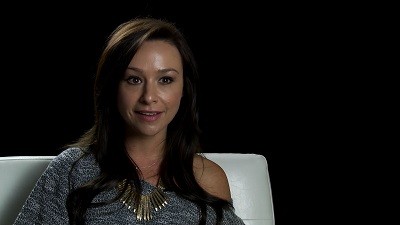 Like its predecessor, the materials for Halloween 5 start with "Inside Halloween 5" (15:10, SD), created for one of Anchor Bay's older DVD releases. Then, the fun begins again with "Dead Man's Party: The Making of Halloween 5" (44:25, HD), which features Akkad, Harris, Cornell, line producer Rick Nathanson, the new Michael Don Shanks, old Michael George P. Wilbur, Wendy Kaplan, Jonathan Chapin, Matthew Walker, Tamara Glynn, Jeffrey Landman, and others. This one features some lovely snippets of B-roll with Harris and Cornell goofing off and having a good time (on-set and off), as well as another entertaining round of stories from all involved. The featurettes crafted for Halloween 6 are all excellent, but I personally prefer the long-form documentary format to a series of featurettes.
Like its predecessor, the materials for Halloween 5 start with "Inside Halloween 5" (15:10, SD), created for one of Anchor Bay's older DVD releases. Then, the fun begins again with "Dead Man's Party: The Making of Halloween 5" (44:25, HD), which features Akkad, Harris, Cornell, line producer Rick Nathanson, the new Michael Don Shanks, old Michael George P. Wilbur, Wendy Kaplan, Jonathan Chapin, Matthew Walker, Tamara Glynn, Jeffrey Landman, and others. This one features some lovely snippets of B-roll with Harris and Cornell goofing off and having a good time (on-set and off), as well as another entertaining round of stories from all involved. The featurettes crafted for Halloween 6 are all excellent, but I personally prefer the long-form documentary format to a series of featurettes.
On the second page, skipping over a couple of supplements (we'll come back to them in a minute), there's a selection for "Horror's Hallowed Grounds", which leads to not one, not two, not three, not even four, but five episodes of Sean Clark's set tour show, for Halloween 4 (25:50, HD), 5 (24:03, HD), Curse (23:09, HD), Halloween (20:39, SD), and a "Bus Tour (11:25, SD), filmed with an entire band of fans. There's so much content on this set and Sean Clark's set tours are so well-known at this point that I'm going to have to admit I didn't watch these, as I personally am not that into set tours. Those who enjoy his show (and again, my disinterest has nothing to do with Clark or the show itself, I'm sure it's great) should be happy to know these are included here.
The disc finishes with some odds and ends, new and old. First is an extremely brief interview with Moustapha Akkad (1:17, SD), as well as a newer interview with Tom Burman (6:00, HD), makeup artist on Halloween III, who discusses the short turnaround time on the picture and creating the masks. TV spots for Halloween 4, 5, and Rob Zombie's films are included, as well as radio spots for Season of the Witch. The set concludes still galleries for Halloween, 4, and 5.
Of course, despite the insistence that this would be the ultimate set, there are still some significant bits missing in action. Both as a Halloween fan and going off of others' enthusiasm, the three biggest omissions here would have to be 1) the continued refusal to acquire and include the additional footage from the original Halloween that a private collector owns and Don May scanned a few minutes of, b) the TV additions and edits not being re-scanned in HD (these are likely included with the aforementioned footage), 3) and the absence of the theatrical cuts of Rob Zombie's films. Zombie also reportedly mentioned that he created a companion 4 and a half hour documentary for Halloween II, which has yet to be released, and many fans also would've liked the option to watch Halloween H20 with John Ottman's original score. There's also the issue of material created or owned by Anchor Bay that isn't incorporated here, such as some extras for Halloween 4 and Halloween 5 (including rumored deleted scenes), as well as the really great series overview, 25 Years of Terror, and Phil Nobile Jr.'s full-length television documentary "Halloween: The Inside Story." Worst of all, as mentioned earlier, the Halloween 4 Blu-ray was actually reauthored for this set to remove one feature, an 18-minute convention panel with Harris, Kinmont, Jenson, and Landman (DVDTalk review of that disc linked at the top of the video section). EDIT (9/29/2014): A look at the disc's title tree, however, reveals that the panel discussion actually is still on the disc, which makes the inability to select it from the menu and watch it and the sync error all the more frustrating.
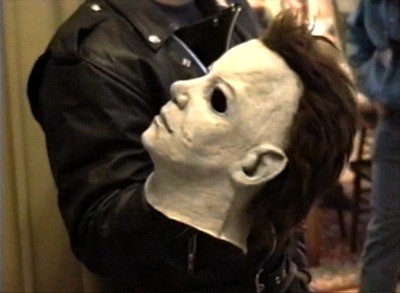 Why were these things left out? Space was undoubtedly an issue. Rights might've posed a problem. Cost was probably a factor. In the case of Zombie's supposed other mammoth documentary, the material may not even exist, at least in a finished enough form. Plus, of course, nobody's perfect. It's a tough situation, because on one hand, there's such a wealth of content here that it's kind of like looking a gift horse in the mouth. At the same time, leaving out existing, previously published material in a "definitive" set is frustrating (especially material as good as 25 Years of Terror), and the near-lack of content on the discs for 4, 5 (especially when so much of the new material is specifically about those films), or the theatrical cut of Halloween 6 is an obvious inefficiency if space was a problem. I'm reluctant to place blame (especially given their participation in the set was no more crucial than anyone else's), but I might venture a guess that Shout! (as a company still actively producing collector's editions of fan-favorite catalog horror) was more of a proponent in making the set great than Anchor Bay, especially given which discs seem to be unbalanced or missing existing content, and it was Shout's lack of freedom to have Anchor Bay's second Halloween disc and the discs for 4 and 5 redone that created the biggest roadblock in organization. The results of their work is simultaneously a fantastic effort and noticeably short of comprehensive.
Why were these things left out? Space was undoubtedly an issue. Rights might've posed a problem. Cost was probably a factor. In the case of Zombie's supposed other mammoth documentary, the material may not even exist, at least in a finished enough form. Plus, of course, nobody's perfect. It's a tough situation, because on one hand, there's such a wealth of content here that it's kind of like looking a gift horse in the mouth. At the same time, leaving out existing, previously published material in a "definitive" set is frustrating (especially material as good as 25 Years of Terror), and the near-lack of content on the discs for 4, 5 (especially when so much of the new material is specifically about those films), or the theatrical cut of Halloween 6 is an obvious inefficiency if space was a problem. I'm reluctant to place blame (especially given their participation in the set was no more crucial than anyone else's), but I might venture a guess that Shout! (as a company still actively producing collector's editions of fan-favorite catalog horror) was more of a proponent in making the set great than Anchor Bay, especially given which discs seem to be unbalanced or missing existing content, and it was Shout's lack of freedom to have Anchor Bay's second Halloween disc and the discs for 4 and 5 redone that created the biggest roadblock in organization. The results of their work is simultaneously a fantastic effort and noticeably short of comprehensive.
Conclusion
All of the Halloween movies have been available on Blu-ray individually, and for the most part, in editions that are very similar to the ones included here. The real promise of this box is the wealth of Shout!-produced supplements, particularly for Halloween 6, which fans have wanted for more than a decade. Cumulatively, the supplementary section of this review is longer than one of my usual full reviews (and that's without detailing the wealth of archival extras here), and yet, there are some significant omissions in this set overall. Were this simply a review of that Halloween 6 Blu-ray, that set would probably earn the DVDTalk Collector's Series rating from me, and new Blu-rays of Halloween, 4, 5, or H20 with the lengthy docs and commentaries would be "highly recommended" at worst. However, a really good feature-length documentary that one of the companies behind this set appears to still own the rights to, as well as a number of other small omissions which could've been solved space-wise with some re-arranging hold this set back from our top score (this aside from the fact that not everyone wants to own the whole run just to get the new content presented here). Shout! Factory's contributions to the set are a home run, with the company delivering on its usual commitment to pleasing the fans. Anchor Bay's discs, however, come up a bit short. Overall, highly recommended.
Please check out my other DVDTalk DVD, Blu-ray and theatrical reviews and/or follow me on Twitter.
|
| Popular Reviews |
| Sponsored Links |
|
|
| Sponsored Links |
|
|
| Release List | Reviews | Shop | Newsletter | Forum | DVD Giveaways | Blu-Ray | Advertise |
|
Copyright 2024 DVDTalk.com All Rights Reserved. Legal Info, Privacy Policy, Terms of Use,
Manage Preferences,
Your Privacy Choices | |||||||









